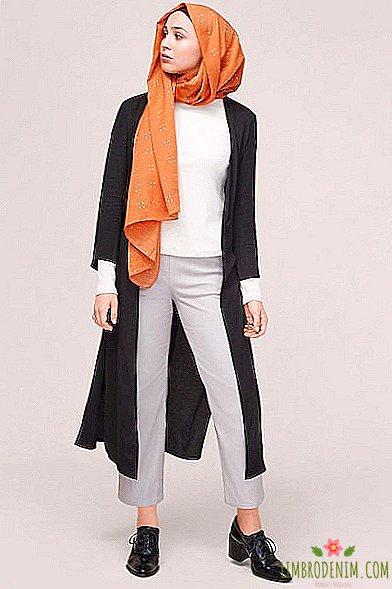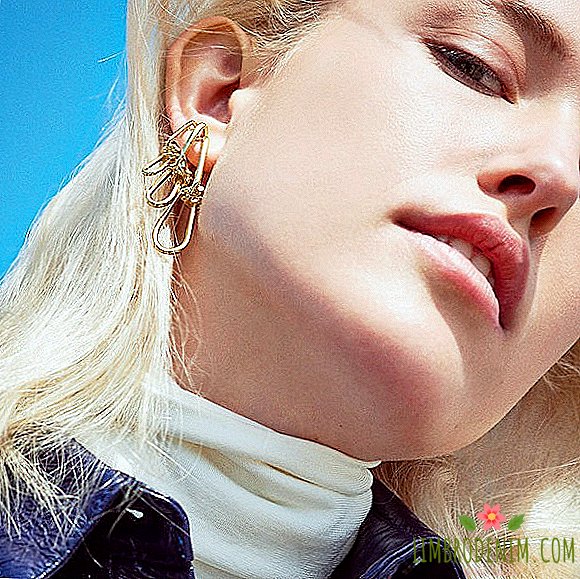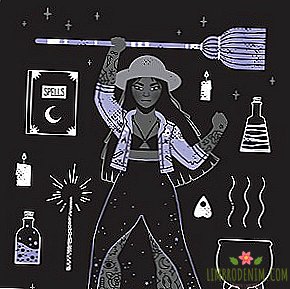Fashion for Islam: How the East dressed us in "modest clothes"
The book "Generation M: Young Muslims are changing the world" Shelina Janmohamed, vice president of advertising agency Ogilvy Noor, decided to write back all the old literature about Islam. Young Muslims, from her words, are tired of sad stories about "wrapped up women with bowed heads abducted and sold", or about people who ride camels across the desert. "We do the usual things, like everyone else around, and we have something to tell," - said Shelina. The political and cultural significance of this thesis is obvious, and for some time now it has become a full-fledged fashion concept.

Even gender ambivalence, which became the number one fashion topic about two years ago, may be related to the influence of Islamic clothing.
Those whom Janmohamed called the “M generation” are Millennial Muslims born over the past thirty years, who, in addition to their age, are united in the belief that their faith and modern life "must go hand in hand, and there is no contradiction between them." They want to carry their religion with pride, but also to be part of the community around them. There are more and more such observant, educated, traveling "citizens of the world" among today's Muslims who have even crossed the age limit that separates millennials from non-members. That does not negate the parallel existence of traditionalists, but already has an impact on the modern fashion market. According to the report, in 2014 Muslims spent $ 230 billion on clothing and footwear, which was already 11 percent of the total world consumption in this category, and by 2020 this figure is projected to increase to 327 billion. And given the fact that Islam is one of the most actively growing religions with the lowest average age of followers (24 years), there is no doubt about this.
At the same time, consumption for “new Muslims” remains a part of identity. They want to buy not just symbols of luxury or beautiful things with recognizable logos, but products that match their beliefs, "when they are confident that they will help them become better Muslims." And fashion brands are actively involved in this game. The first was the team DKNY, which released the capsule collection for Ramadan. Uniqlo, Mango and Tommy Hilfiger followed up with the same initiative. Dolce & Gabbana prepared for Muslim countries a separate line of abai with their signature "Sicilian" prints.
Burkini - swimsuits covering the body from the ankles to the head, which have become the subject of much controversy in France - began to be sold at Marks & Spencer. Uniqlo recently released a separate line of "modest clothing" - this is no longer a capsule, but a permanent category in their range. And Nike has developed special hijabs for sports. Even small local brands, for which the marketing department does not stand, vigilantly following the demands of society, regularly turn to the subject of Islam - to recall at least the recent collection of our designer Asiya Bareeva.


Fashion analysts speak of a noticeable influence of the East on world podiums and on modest wear as a new meaningful trend: quotations are found both in layering and in the ensemble of dresses and trousers, and high collar, and in the fundamental closeness of the body. But numerous small brands of modest wear and even offshoots of big brands are still a niche story, separate from the general line. There is no pronounced aesthetic and semantic movement towards "modest fashion" according to the canons of Islam in the modern fashion industry. Although habits, tastes, and aesthetics of the Muslim world penetrate the culture at different levels. The world today is a big melting pot, where representatives of very different cultures, migrants and indigenous people live side by side, and along with each newcomer to the metropolis comes the baggage of its national traditions, from behavioral norms to costume details.
The overall portrait of any city is made up of the images of all the people living in it - and the trends books and the designer’s collections all trends come from observing the life and style of the streets. Therefore, for example, Christoph Lemaire says that the images from the spring-summer men's collection — shirts-dresses with trousers, jackets with pockets over city suits — were peeped by older Arabs living in Belleville, and turbans and their variations have long become quite common and in European fashion, although they came into it once from the East. Sometimes these effects are obvious, sometimes not at all. Even gender ambivalence, which became the number one fashion topic about two years ago, may be related to the influence of Islamic clothing.
“It turns out unconsciously,” says Anzor Kankulov, editorial director of Numéro Russia and head of the Fashion program at the HSE Design School. “You just live, you see the emigrants who live next to you. In a topic that Europeans have rethought as gender ambivalent fashion As I think, the role of ethnic influences is great. But they simply were not so meaningful. Roughly speaking, when you are asked to wear a very long shirt without a collar, leggings and sneakers, you look exactly like a guest from Qatar. as a gay man from the Marais, and can be - as the Arab prince. "

It was the calls to disrupt the veils from the girls of the East, bringing them in line with modern Western norms, that until recently were the essence of the relations of the Western world - including fashion - with the Eastern
Another argument in favor of the fact that modern streetwear is formed under the influence of Muslim culture is that street life, in its current sense, heavily implicated in crime, sports and music, grew out of African American communities. Many of their members in the 20th century, during the time of active struggle for their rights, went through initiation just by Islam. In the history of the last century, Mohammed Ali was, although today these moments are remembered rarely and with reluctance, the Nation of Islam and the Black Panthers are anti-racist groups that quickly turned into nationalists. Islam was their main religion, as opposed to Christianity, imposed, as their leaders said, on black Americans in the years of slavery by rich white planters. And its adoption, the rejection of the religion of the oppressors, was an important stage in the lives of many African Americans. Tupac Shakur, an icon in music and in style, was also a member of Black Panther, and Islamic influence is clearly readable in his image — in the manner of wearing Arafat, even in the way of shaving a beard.
The world is now - for the first time, it seems, the whole history of its existence - is centered around "women's" issues. It is their discussions that become the main topics of the modern social agenda. Western men, who were unaccustomed to this lack of attention to themselves and confused by the “encroachment” on their powerful and powerful positions, came to a self-identification crisis. There is a lot of talk about what masculinity means in the modern world, but today there is no single answer and, most importantly, a ready-made image that has always been before. Having been thrown out of a well-built system "must" and "should", Western men begin to look for ready-made samples in other cultures, where the distribution of functions for gender is still strong.
“To put it bluntly,” explains Anzor Kankulov, “European men feel weak. That is why such a pronounced wave of enthusiasm for all post-Soviet became such a“ post-Soviet ”is just equal to brutal.” And the Arab men see the same in the West: more traditional type of masculinity. At the same time, in societies where there are very clear gender models, it is within their framework that some experiments are allowed. They do not dispute the essence. That is, even if you make up, you will but it's nothing - you're a real man is handsome. "
In women's fashion, however, everything is somewhat different. Since in the "women's" issues Eastern culture is in marked conflict with the Western, any direct borrowing is excluded. Girls of the East, unlike men, are perceived not as strong role models, but as victims demanding salvation. “I have always believed that a designer should make women beautiful and give them freedom, and not take the side of a violent dictatorship, of this disgusting way of hiding women,” says Pierre Berge, for example. “The fact that women are forced to dress like husbands, families and their environment does not mean that you have to support this path. On the contrary, you have to teach them to undress, rebel, live like today's women all over the world. "
It was the calls to rip the veils from the girls of the East, to “release” them, bringing them in line with modern Western norms, although not so literally expressed, until recently were the essence of the relations of the Western world - including fashion - with the Eastern. This conversation is conducted from the standpoint of colonial domination, in which there is the only correct approach, Western.


What is already there, is already integrated and has practically ceased to be read as borrowed in fashion, quite a lot today. These are the same silhouettes, which were discussed in the part about the men's fashion, and some beauty-trends - like Insta-makeup with super-brows or intricate Smoky Eyes. Even the increasingly popular female body image with more lush, smooth forms, in the spirit of Kim Kardashian, is in some sense the ideal of Guria, an oriental beauty, whose image for European men has become a costume designer Leon Bakst as a heroine. Even the first prototype of modern women's trousers, bloomers, was inspired by Turkish clothes: it appeared as an alternative to corsets and crinolines, that is, as a piece of clothing intended just for “liberation”, but for women of the West. But the main stumbling blocks are still capes, veils, scarves, interpreted as religious symbols. It is they, and not covered hands, legs and collected hair that cause anxiety to the average European.
Today, not only gender norms are shattered, but the entire structure of the world. And the Western world feels this turbulence: by 2050, according to forecasts, the number of Muslims in the world should be equal to the number of Christians. Consequently, the position of Western culture as dominant today is not as strong as before. Europeans are frightened by migrants, the fear of the Islamization of society is frightening, and the terrorist threat, which is inextricably linked to radical Islamism in the mass consciousness, is frightening. Fear of an unclear threat often causes a very radical reaction in European society.
“Breaking the burqa” begins literally: more and more stories about how girls are attacked on the streets, tearing off their hijabs. Or, like after the ban, burkini and veils on the beaches of Muslim women are surrounded by policemen, almost forcing them to undress. At these moments, the Western desire for freedom is already becoming an instrument of oppression, which the women of Islam in no way deserve even from their zealous “liberators”.


Shelina Janmohamed, describing her "generation M" is dedicating the book "to her girls." "Because you can do anything," that is, to be anyone, to follow your own dreams, without trying to fit into the framework, which they see from the East or the West. And if we consider the task of fashion “liberation” of women, then instead of imposing someone’s own idea of freedom, you should listen to the words of the generation M itself: hijabs, burkini, etc. allow you to live the life you want in the traditions of your religion. To do sports, science, creativity - and in this sense, of course, they are free. Those young Muslims who are turning to the fashion industry now are not the radical Islamists who came to power in Iran in 1979 and the secular state turned into a dark realm of non-freedom. Therefore, there is little reason to expect that by 2050 our world will turn into its scaled likeness, and Islamic "modesty" will become a law.
Cultures continue to mix, the world continues to change, and strange and fascinating stories flourish at the confluence of different cultures. About the silent vampire in abaya, cutting through the city at night on a skateboard, as in the movie "Girl Walks Home Alone At Night". About nomads party people dancing in the desert under the "Bad Girls" M.I.A. About superheroines in bright, albeit "modest" clothes, saving the world along with Spider-Man and Captain America. A riot is ripening under black capes or scarves on their heads, just as he ripens under the caps of the Supreme or the hats of Gosha Rubchinsky.
Photo: Nike, Uniqlo, Asiya Bareeva, Elie Saab




